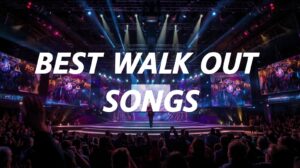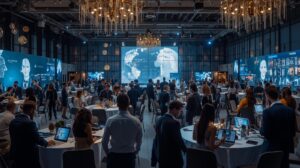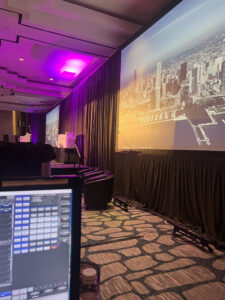Designing a stage for event is not only the act of setting up an audience in front of a platform. It is the process of making a place where one is engaged by the space, a narrative, and a push of the experience forward. Whether it’s a corporate presentation, live concert, award ceremony, or any event where the stage becomes the center of attraction, the way you design a stage for an event makes all the difference. When done correctly, it keeps the audience engaged and supports all the technicalities behind the scenes.
Huview Productions is an AV production company in Atlanta that brings hands-on expertise in event staging services, design, lighting, and technical coordination, ensuring each setup supports both the visual and functional needs of your event.
This guide will give you a step-by-step guide to creating a successful event stage design, as well as touch on the important aspects of stage design through key concepts, essential parts, and how to make the stage both dynamic and effective.
What Is Event Stage Design?
Event stage design refers to the identification of how a stage should appear, operate, and translate to the ambitions of an event. It is a combination of being creative and logical, more than picking out some colors or lighting.
An effective stage design is a smart, planned use of the space, a flawless combination of the lighting and sound systems, orientation to what the event is all about, and making the set-up look amazing in real life and on camera.
Why Stage Design Matters for Events
Your speakers and performers are not the only things that can be found on the stage. It does a lot more than that.
Sets the tone and energy of the event
The way your stage looks and feels immediately influences the mood. A well-lit, sharp design gives energy. A soft, warm look feels intimate. The first impression is powerful, and it comes from your stage.
Impacts audience experience and engagement
A proper arrangement can keep individuals more concentrated. When things are not visible or audible, or people cannot keep track, they will not be engaged in the event. However, when there is a nice stage set-up, eyes are where they are supposed to be.
Influences how speakers, performers, or brands are perceived
The quality of an event is determined by stage quality. Your presenters look more reputable with an elegant design. A disorganized or awkward stage setup does the opposite.
Essential for safety, flow, and production logistics
Event Staging has to be practical as well. The right access, easy exits, firm platforms, and proper cable management are important. A badly constructed stage may slow down the program or, worse, cause injuries.
How to Design a Stage: Step by Step Guide for Events
The stage design varies depending on the type of event. Depending on the very nature of the event, you will practically need to come up with an accurate stage setting. By utilizing the six-step guide, you can learn how to create a stage design for an event.
Step 1: Outline the Purpose of the Event
The most appropriate step that should be taken is learning the main purpose of the event. It is easy to draw a stage with precision and detail when you understand why an event is taking place. Moreover, finding out the purpose of the event will also provide you with a clue about the design elements needed. Most important of all, you will be able to go about the following aspects of stage design with a clear mind.
So, you can ask simple questions such as:
- Do you want to set up a stage for a concert or a corporate conference?
- Is this a stage design for a live concert event?
- Is it an event to launch a product or an award function?
Specifying the purpose will make you understand whether it should have a minimalistic design or a large, lavish stage. Moreover, you will be given a chance to choose the correct features and stage accessories.
Related Read: Corporate Event Stage Design.
Step 2: Determine the Stage Size
Choosing an appropriate stage size is crucial for your event’s success. In case you have a small room or space to conduct a small event, the compact stage would be appropriate because it is snug and makes the speaker or entertainer closer to the audience. But a big hall or gathering with 500 people will require a bigger platform to be seen and noticed.
It is not only width and depth that are important, but also stage height is important. When the venue is bigger, the height of the stage can be increased so that everyone can see the activity accurately, including the people in the back row. However, beware, the stage that is too tall in small gathering places may be intimidating and leave a gap between the audience and the announcers.
The event stage should have the capacity to allow free movements and safe and accessible avenues to accommodate all the requirements of the production process, a capacity that is not too much to accommodate performance or too much to accommodate the audience on stage.
Step 3: Select Stage Shape and Texture
The shape and the texture of the stage are important in defining the mood and purpose of your event. The stage is a place where everyone looks. It must fit the flow of the event, the audience, and fashion.
The most common shapes of stages are presented in the form of a rectangle because of its versatility. It is efficient in all sorts of corporate presentations, as well as concerts. A circular stage depicts a 360-degree experience, which brings a guest around the stage, making it more intimate and involving. The T-shape is ideal during fashion shows or any event where there is a majestic entry; the T-shape stage allows the audience to get closer to them.
A thrust stage is an arrangement in which the performers are closer to the attendees on three sides, and this makes the performers more involved as the stage ensures backstage functionality. The arena stage allows the most interactive experience with the crowd all around the stage area, but lighting and sound have to be well planned on this stage.
Stage perception is also dependent upon textures and materials. Wood makes a traditional, warm appearance, which suits formal functions. Acrylic is a sleek, modern finish, ideal to use during the launch of a product or a tech affair. Stages covered in carpet enhance the sound and comfort, best during panels or talks. The LED flooring gives the wow factor and makes the stage a center of attention, an interactive piece of visual art.
Step 4: Pay Attention to the Stage Layout
It is equally crucial that the layout of the stage is as good as its size or shape since it defines the effectiveness of the space operation during the event. Composed design serves the purpose of ease of movement, visibility, and interactive experience with attendees on both sides (on-site and online).
Begin by deciding on where the speaker or performers are going to stand, walk, or communicate. Locate such objects as the podium, LED screens, musical instruments, props, or furniture in strategically appropriate ways so that they do not hinder vision and movements. Have free and safe access as well as exit doors for presenters and crew, particularly in live situations, as time is a key factor.
Conducting a sightline with the audience will always. The wrong placement of a certain object or an angle may spoil the satisfaction of viewers seated more at the end or at the side. Additionally, camera plan: consider where some key moments can be placed so that they will come out well on screen.
Draw your layout or work on 3D visualization and look at it from various angles to have it perfect in terms of visibility and circulation.
Step 5: Pick a Color Scheme
Selecting an appropriate color scheme is one way of creating the mood and enhancing your event identification. The colors you use on your stages should match your event theme or brand as well as fit the lighting design. Ditch white paint and materials to use stage lighting to add or transition the flow of color as the event unfolds. This gives freedom to other segments or moods. Use three basic colors to be constant and harmonious. Avoid using a fourth color unless it has a certain purpose, such as to point out a keynote speaker or a dramatic moment on stage, as it seems to clutter what you are trying to see.
Step 6: Choose AV Equipment
AV equipment and stage design go hand in hand. The perfect AV installation gives clarity to your message in terms of being seen, heard, and felt.
Some of the essential AV equipment is an LED screen or a projector to support the visuals, microphones (lapel, handheld, or headset) to deliver quality sound, and speakers and monitors to cover the venue.
Confidence monitors assist presenters in concentrating without looking away. The lighting controls allow the transitions and the change of moods. It is not necessary to make guesses, but one has to involve professionals at the early stages of planning. Hiring professional AV teams such as Huview Productions would guarantee a smooth process and a good professional experience.
Key Elements of Effective Event Stage Design
An excellent stage design is not merely the one with a platform and a microphone; it is a set of nicely balanced elements presented in a way that is complementary to each other and creates a smooth and involving experience. This is what constitutes a professional and complete stage design:
Event Stage Accessories
These elements help make your stage practical and polished.
- Podiums provide a venue for notes or gadgets and assist in having a confident speech.
- Risers provide the height and depth that are needed, especially in cases where bands, choirs, or group panels are involved.
- Stools or lounge chairs are preferable when one wants a relaxed interview or panel.
- The branding is strengthened with the help of backdrops and banners, which help to provide visual interest.
They should help you tell a story or strengthen your theme and provide characters for the stage.
Lighting Fixtures
Lighting defines the atmosphere of your event.
- Spotlights draw the attention of essential people or moments.
- Wash lights are used to provide soft, even color on the stage.
- Dynamic motion and energy are achieved by moving heads.
- Logos or patterns can be projected by use of a gobo on the walls and floors.
- The programmed lighting will allow you to set moods for each segment: intros, speeches, performances, or closings.
Audio Equipment
Audio is non-negotiable. Equip your stage with:
- The PA systems make sure that everybody is assured of hearing.
- With wireless microphones, there is freedom of movement.
- Mixers make sound adjustments to various sources.
- The acoustic treatment can be used to reduce the echo and enhance clarity in difficult rooms.
Visual Elements
Visuals give context and excitement.
- LED walls are used to show either videos, graphics, or animation.
- Projection mapping converts objects to moving images.
- Areas of identity and continuity are achieved with branded backdrops.
- Live feeds are useful in enabling viewers, especially a large number of them, to view the action in close-up.
IT Equipment
Modern stages need smart tools:
- Teleprompters and confidence monitors help presenters stay on track.
- Cue systems are transition management.
- Virtual audiences are backed by streaming equipment.
- Never forget to make backups of your technology, as there may be technical issues that destroy an entire event.
Final Thoughts on Designing the Perfect Event Stage
Stage design does not decorate the stage event; it is a strategy at work. It contains your message and backs your team as well as frames the entire experience of your audience. And since you are working on the content, don’t let a poor stage steal your work.
Huview Productions offers total stage designs and expert audio visual production that are compatible with corporate, entertainment, and live events. We create stages that are clean and efficient and ensure you connect with people.
Why is stage design important for events?
Stage design sets the tone of your event, impacts audience engagement, and helps reinforce your brand message. A well-designed stage also ensures better flow, safety, and technical execution.
How do I choose the right stage design for my event?
Start by understanding your event’s purpose, venue size, audience expectations, and AV needs. Then choose a layout, lighting scheme, and visual elements that match your goals and theme.
What elements should be included in a stage design?
Key components include:
Stage layout and height
Backdrops or digital displays
Lighting fixtures
Audio equipment
Visual and projection elements
Staging accessories like podiums or steps
How does lighting impact stage design?
Lighting enhances mood, directs audience attention, and ensures performers or speakers are visible. Proper lighting design is essential to complement the stage structure and visual theme.
What is the role of AV in stage design?
Yes. Many AV companies, including Huview Productions, offer stage design packages with rental equipment such as trusses, lights, audio gear, and digital screens.







